 Have you ever felt like Life was pointing a great big arrow at something, waiting for you to notice it? Well, it happened to me last winter. It seems that everywhere I looked I'd come across info about the health benefits of fermented vegetables. It sort of culminated with our neighbors giving us a big head of cabbage, as they were going away for a few weeks.
Have you ever felt like Life was pointing a great big arrow at something, waiting for you to notice it? Well, it happened to me last winter. It seems that everywhere I looked I'd come across info about the health benefits of fermented vegetables. It sort of culminated with our neighbors giving us a big head of cabbage, as they were going away for a few weeks.Having suffered from candida for years, one of my weaknesses has always been my digestive system. Needless to say I became very intrigued by cultured veggies' healing properties so I decided to 'pay attention' to what Life was trying to tell me and see for myself what the fuss was all about.
Fermenting For Health
Fermentation is a process by which foods are pre-digested by friendly enzymes, fungi, and good bacteria. As Mike Snyder pointed out in his March 2007 newsletter, this makes fermented or cultured foods "easier to digest, releases nutrients and increases the enzyme levels".
Some of the health benefits of fermented veggies include:
- strengthening the immune system
- having a soothing effect on the nervous system (They are known to be beneficial to children with autism and ADD.)
- alleviating intestinal disorders and creating a healthier digestive system by supplying beneficial flora and bacteria (also called probiotics). As Dr. Joseph Mercola puts it, fermented veggies form "a 'living shield' that covers the small intestine's inner lining". It is said that they also prevent bacteria and fungal overgrowths (albicans candida).
- helping to regulate weight and appetite by reducing cravings for sugar, soft drinks, bread and pasta.
Erica of SchoolOfRAWk has also written a great, very informative article explaining why "Fermented Foods Are Essential For Health". Check it out here.
Sauerkraut 101
There are a variety of fermented foods, many of which were traditionally part of our ancestors' diets. These include veggie-kraut, kimchi, kefir, yogurt or cheese made with nuts and seeds, rejuvelac, miso, Nama Shoyu (unpasteurized soy sauce), kombucha tea (which I recently started making too, but that's for another post!), and of course, the well-known pickles and sauerkraut.
The Quest For The Right Tools
Having no special equipment, at first I resorted to using a large ceramic pot with a plate and a weight on top. When I read about how unfriendly bacterias can easily develop if sauerkraut isn't made under the right conditions, I decided not to take any chances and to throw that first batch away. That prompted me to start looking for proper equipment; if I was to give sauerkraut making a serious try, might as well do it right!
I knew of the traditional ceramic crock pots, but these are costly and therefore weren't a real option for me. Then I came across a post on Raw Food Talk recommending the Pickle, Sauerkraut and Kimchi Maker sold by Mike at his The Raw Diet Heath Store. It had a lot of great reviews and, best of all, was quite inexpensive (about $30 including shipping). My search was over!
(Note: RawVegan4Health has ingeniously come up with a home made version of the Sauerkraut and Kimchi maker for roughly $9. He has posted the instructions on our forum, Raw Freedom Community.)
Now, some 4 batches later, I'm by no means an expert at sauerkraut making, but I thought I'd share some of the valuable things I've learned along the way.
Preparing The Cabbage
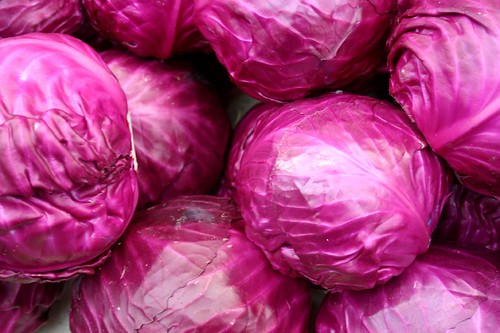
I like using a mixture of green and red cabbage as the resulting color is just stunning. One of the things I most enjoy about this system is how, as you'll see, you can watch the cabbage change color from day to day, turning into a bright fuschia. Nature's artwork!
I've come across recipes suggesting that you need 5 lbs of cabbage total to fill up a gallon jar, but I always end up using about 9 lbs.
The first thing I do is clean all of my equipment really well. Scalding is a good idea in order to sterilize it and prevent potential problems during the fermentation process.
I then remove the outer leaves, chop the cabbage into medium chunks, then put these through my food processor, using the smallest slicing blade. Alternatively, you could shred the cabbage with a mandoline or a sharp knife. I end up with some nice, fine cabbage strips. (Well, for the most part anyways...)

I don't know if it's because my food processor isn't so hot, but it leaves some pretty coarse pieces as well, so I just pick these out and process them separately with the S blade.

I then put the chopped cabbage in large bowls and add sea salt; the usual ratio is 5 lbs cabbage/3 tbs sea salt. You want to make sure to use enough as I've lost a couple of batches due to them not being sufficiently salted. Major bummer after all that work! I have read that you can use seaweed as well, but have yet to try it.
I also recommend throwing in a few capsules of probiotics. (You can find these in most health food stores.) I usually mix in 3 caps per gallon jar, along with the salt. This considerably quickens the fermentation process by giving a boost in friendly bacteria. My last batch of sauerkraut was ready in 5 days instead of the usual several weeks!!! I think Gabriel Cousens uses miso in his recipes for the same purpose, plus it also acts as a salting agent.
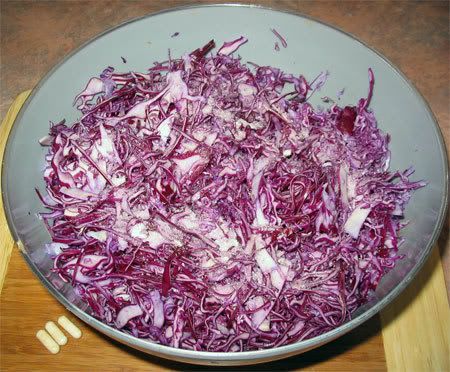
Next, it's time to do a little work out! I massage the cabbage/salt/ probiotic mixture for a few minutes in order to help release the juices. There are all kinds of ways to achieve this; I've tried stepping on the cabbage with my bare feet (messy!!! lol), and I think Erica of SchoolOfRAWk uses a baseball bat to pound on the cabbage (he he), so you can be creative and see what method you like best.
For my part, I find that pressing down on the cabbage with another bowl works really well and is simple and quick.
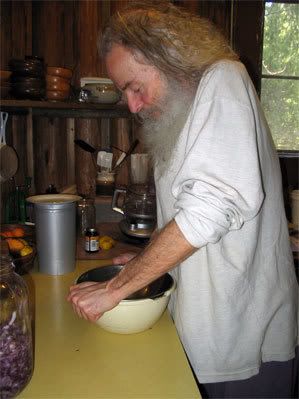
At this point, you can also mix in other veggies (carrots, greens, Brussels sprouts, celery, zucchini, turnips and beets), herbs and spices (caraway seeds, dill seeds, celery seeds, juniper berries, onion, garlic, hot pepper, turmeric, ginger or burdock root) or even fruits (usually apples). You can totally experiment. For my part, I'm quite happy with a few cloves of garlic.
I then pack the cabbage tightly in the jar, a little at a time, to make sure there are no air bubbles trapped in there.

I fill it right up to the bottom of the jar's neck so that once I insert the small cap upside down, the latter is level with the jar top. The reason for this is that the big cap will then press against it and keep the cabbage submerged in liquid which is key.

I fill it right up to the bottom of the jar's neck so that once I insert the small cap upside down, the latter is level with the jar top. The reason for this is that the big cap will then press against it and keep the cabbage submerged in liquid which is key.
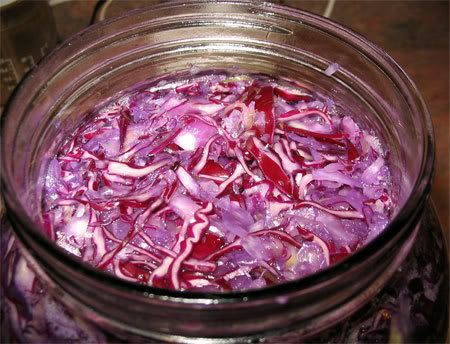
Here's the small inverted cap which I then fill with water to the very top. I know you can't see much but the water is in there!
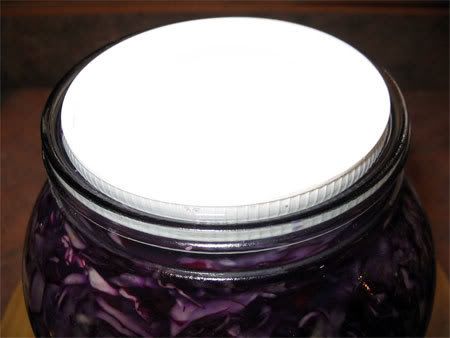
Next, I remove the small rubber plug from the grommet and screw the big cap onto the jar. Water or brine should come out of the little hole. If it doesn't, simply pour in more water until it does. Then I fill the air lock with water to the line on the outside cylinder and insert the air lock into the cap grommet.

Finally, I set the jar in an non-obstructive corner of the kitchen counter. A lot of juice gets released during the fermentation process, so you definitely want to put a plate or a dish underneath the jar, and drain it as it fills up. Let the whole thing sit at room temperature (60 to 70 degrees).
This is the part that thrills my inner child! The kraut will soon start doing its thing. I just love watching the fermentation process; brine and bubbles coming out. After a couple of days, I start checking on the level of liquid inside the jar, adding some brine (ratio 1 cup water/1 tsp salt) as needed to ensure that the cabbage remains submerged.
The sauerkraut should be ready after 4 or 5 days, depending on the room temperature and provided you use the probiotics. Our house gets pretty cool at night in the wintertime so it has taken as long as 6 or 7 days. You can tell that it's ready when there are no longer any bubbles coming to the surface. You can also taste it; it should have a pleasant tartness and be crunchy. (If the sauerkraut is soft, do not consume it!)
Behold The Transformation
What follows is a series of photos to give you an idea of the different stages of the fermentation process. The pics were taken from a batch I made in the Spring.
The sauerkraut should be ready after 4 or 5 days, depending on the room temperature and provided you use the probiotics. Our house gets pretty cool at night in the wintertime so it has taken as long as 6 or 7 days. You can tell that it's ready when there are no longer any bubbles coming to the surface. You can also taste it; it should have a pleasant tartness and be crunchy. (If the sauerkraut is soft, do not consume it!)
Behold The Transformation
What follows is a series of photos to give you an idea of the different stages of the fermentation process. The pics were taken from a batch I made in the Spring.
End of Day 1

Day 2

Day 4
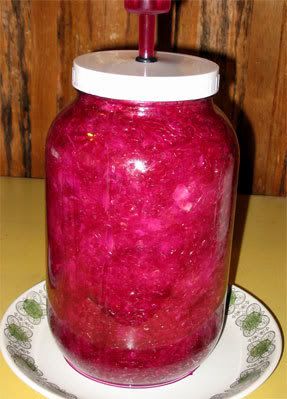
Day 5

Tada! The best sauerkraut you've ever tasted!!! I sometimes need to add a little brine when I transfer to individual jars since liquid tends to 'shrink' when exposed to cooler temperatures.
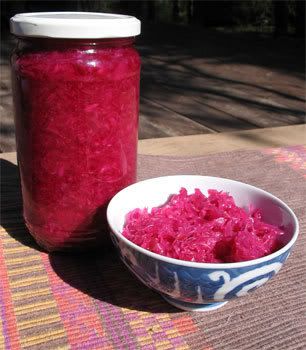
If you have a sensitive digestive system, you may have to work up your tolerance by consuming 1 tablespoon of sauerkraut a day for a week or so. That's what I had to do initially, and now I'm eating lots pretty much every day (and LOVING it!) The kraut will keep in the fridge for months. In fact, you'll find that it will continue getting better and better. So yum!
Commercial fermented products found in supermarkets and stores are usually pasteurized. In other words, they are no longer 'alive', and the enzymes and beneficial bacteria have been destroyed. Not to mention all the salt, sugar and preservatives that they may contain! Yet another reason to start making your own!
If you would like to find out more about fermented veggies, there is loads of info available on the net. As I was mentioning earlier, Mike's site is awesome. You might also want to check out Chet Day's Health & Beyond for instructions on sauerkraut making. And there's of course the 'mecca' of fermented veggies: Sandor Ellix Katz's WildFermentation.com.
Happy sauerkraut making!
Day 5

Tada! The best sauerkraut you've ever tasted!!! I sometimes need to add a little brine when I transfer to individual jars since liquid tends to 'shrink' when exposed to cooler temperatures.

If you have a sensitive digestive system, you may have to work up your tolerance by consuming 1 tablespoon of sauerkraut a day for a week or so. That's what I had to do initially, and now I'm eating lots pretty much every day (and LOVING it!) The kraut will keep in the fridge for months. In fact, you'll find that it will continue getting better and better. So yum!
Commercial fermented products found in supermarkets and stores are usually pasteurized. In other words, they are no longer 'alive', and the enzymes and beneficial bacteria have been destroyed. Not to mention all the salt, sugar and preservatives that they may contain! Yet another reason to start making your own!
If you would like to find out more about fermented veggies, there is loads of info available on the net. As I was mentioning earlier, Mike's site is awesome. You might also want to check out Chet Day's Health & Beyond for instructions on sauerkraut making. And there's of course the 'mecca' of fermented veggies: Sandor Ellix Katz's WildFermentation.com.
*~*~*~*
Photo Credits
green cabbage 2 by L0is
Red Cabbage by marcusfrieze
Technorati Tags:


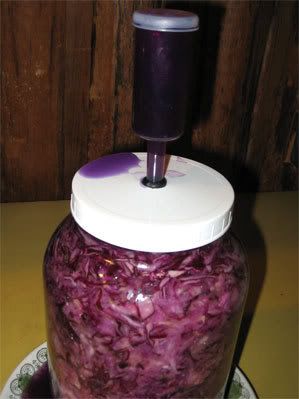

























Hello! Just wanted to let you know that I am enjoying your blog. You make raw food look so beautiful and delicious. It looks like works of art!
ReplyDeleteI am confused about fermented foods. I always thought that if you were suffering from candida you were supposed to stay away from all fermented foods, vinegar, and dried fruits. Yet, I have read that many people cured themselves from this on a raw diet which consumes many of the above foods. Could you clarify? I am new to all of this!
Thank you!
Hello Carrie,
ReplyDeleteGlad you are enjoying my blog!
Unfortunately, I am by no means an expert on the subject of Candida. All I can say is that I used to suffer from it, and after following a mostly raw diet of fresh fruits and vegetables, seeds and nuts for over 6 years, virtually all of my symptoms are gone. I have also recently started consuming fermented cultures such as sauerkraut and kombucha tea.
For more information on candida and fermented veggies, I recommend you check out this link:
http://www.mercola.com/forms/veggie_starter.htm
For an interesting (and quite different) perspective on Candida, see this:
http://www.rawfreedomcommunity.info/forum/showthread.php?p=8300#post8300
Hope this helps,
Carmella
I am interested in knowing if the air lock would function without the addition of the bacteria and allow the cabbage the full 6 weeks of fermentation on its own.
ReplyDeleteHello Scott,
ReplyDeleteIn the docs that came with the Kraut maker, there's a recipe that doesn't call for probiotics so I should think it would fine. Not sure how long the fermentation process would take, but you could tell the kraut is ready when there are no longer any bubbles coming to the surface or simply by tasting it along the way.
Hope this helps!
Hi Carmella,
ReplyDeleteAs usual, I consult your blog first for any questions, and it's an excellent resource. I made some kraut a few days ago, but tried to take it a step further by adding the leftover juice from a previous (and yummy) batch to the new batch. I realized a few days later that it might not have been such a good idea at room temp. I put the new batch in the fridge after day 3, and now a week later, just removed my cover, scraped a few unappetizing bits off and tasted it. Texture and taste are all fantastic but am I asking for trouble? Any experience you might share would be greatly appreciated!
Lisa
Hi lisag,
ReplyDeleteI'm so happy that you find my blog useful on your journey towards health. Awesome!
I've never personally used an old batch as starter for the new one, but I've heard of others doing so. Plus, the key is that yours seems to have turned out really well so I'd say 'don't worry about it'. ;-)
Thanks for the information! I've been trying to find the best way to make sauerkraut. I decided to order the maker that you have. This way I can ensure that no stray pet hairs get into the mix :D
ReplyDeleteHopefully, older cabbages will work out with a bit more effort, but we'll see.
Thanks for the great info Carmella!
ReplyDeleteOne question...and I don't know if it matters much...what type of sea salt is preferred? Iodinized salt or without the iodine?
Thanks Carmella!
mm
You never want to use iodized salt, it will sometimes make the product mushy as well as giving it an "off" flavor. Any pure salt will do such as sea salt or kosher.
Deletemesillamaan,
ReplyDeleteDon't think it really matters. The one thing I've noticed in sauerkraut making though is that 'Real Salt' doesn't work so well. I think it's got to do with the other stuff mixed in (ever noticed the little red specks?)
Hi;
ReplyDeleteWhat a great site this is! It’s a treat finding others who share the passion for sauerkraut and cultured vegetables, so much information here!
As this is my first post, perhaps I should introduce myself: I’m a professional potter, who specializes in hand-made stoneware fermenting vessels, for the home production of quality sauerkraut, kimchi, and other cultured vegetables. I have an enthusiastic local clientel, but I had no idea that there were so many sauerkraut devotees out there!
If any of you are interested, you can learn a little about my work by visiting my website: http://www.artatwork.ca/fermentingvessels. I’ve attached a few photos of my more recent pieces. And, of course, you can always find me here, should you want to ‘talk shop’.
Looking forward to participating in this forum!
Isidora Spielmann,
Spielmann Fermenting Vessels
www.artatwork.ca
isi_s@rideau.net
Hello there,
ReplyDeleteThank you so much for this post. I was wondering which probitotics you use with the sauerkraut?
Thank you so much.
Also, when you end up using 9lbs instead of 5, do you still only use 3tbsp of salt?
And the 5 lbs of cabbage, are you weighing the cabbage before it is chopped up? So if 1 cabbage equals 2 lbs are you using 2 1/2 cabbages?
Thank you so much.
C,
ReplyDeleteI don't use a particular brand of probiotics, just whatever was available at my HFS.
The general cabbage/salt ratio is 5 lbs/3 tbs salt so 9lbs would be about 5 1/2 tbs salt.
Good point about the weight. Those measurements for the cabbage were taken at the store so before it's shredded. In reality I'm using less than 9lbs cabbage once the outer leaves and the core have been removed.
I wish you successful sauerkraut making!
Thank you so much for your reply. I appreciate it. So you yourself buy 9lbs worth at the store and then it ends up being a little under after coring etc. And you add 5 1/2 tablespoons of salt to that in the gallon jar?
ReplyDeleteAnd the probiotics, you buy whatever is available. Are they just regular probiotics, or raw probiotics? I ask because I have heard many theories regarding the probiotics that are made from soy etc.
Thank you again. I really appreciate it.
C
No problem! Glad I can be of help! ;-)
ReplyDeleteYep, I shred my 9 lbs cabbage, toss it well with 5 1/2 tbs salt and probiotics, press down on the mixture to help release some of the juices (as shown in post above), then pack it tightly in the gallon jar.
Hum, I'm really not familiar with the theories around the various probiotics. I don't have a bottle with me so can't really tell you what type mine were.
Hello,
ReplyDeleteI am making this without using the probiotics. I wondered how you know when it is done?
Thank you.
C
C,
ReplyDeleteHum, not sure as I've only worked with the other method, but my suggestion would be to taste it. It should be tasting vinegry. If the kraut is soft instead of crunchy, do not consume it.
Thank you for your reply.
ReplyDeleteI did the whole process but after the first day liquid is no longer coming out and spilling over? Does this mean something went wrong? Liquid only spilled over the first 24 hours.
Also, I did not use probiotics.
I've made many batches of sauerkraut without anything but salt (RealSalt) and cabbage. The easiest way I've come across to figure out salt content is just to weigh it. 2% by weight. So, 400g of cabbage would need 8g of salt. Much easier to weigh in grams. Plus you can weigh it in batches as you add it always using the 2% formula. Then no matter how little or much you make it's always the same.
ReplyDeleteKeith
I made some according to the recipe, put it in the fridge and went out of town. I sort of forgot about it and when I returned opened it to find the liquid had evaporated out of the top 5-6 inches (tossed most of it in the compost pile), below that there is at least 3 inch layer that is moist. The moist cabbage tastes okay, but I'm not sure if it's the right 'raw sauerkraut' flavor. I'm not sure if there is standing brine below that. Would you throw out the batch & start again? Thanks!
ReplyDeletethanks a lot, great advice, will try it today
ReplyDeleteHiya,
ReplyDeleteI am a newbee for making sauerkraut so I am still figuring out what it is suppose to taste like. My first batch was green and purple cabbage with caraway seeds that fermented for only 3 days before refrigeration (with whey and salt) - it was pretty strong stuff, but man it was an awesome mover. This next batch I added carrot and red onion with celery seed instead of caraway seed. I allowed it to ferment for 5 days. The flavor and smell of this batch is completely different. It has a vinegary smell to it and the flavor seems milder, with a vinegary overtone. Is this right? Its now in the fridge waiting to chill and I would hate to think I need to throw this away because I didn't do it correctly. thanks for the input.
Sorry guys for not responding sooner but I didn't see your comments until a couple of days ago. ;-(
ReplyDeleteAnonymous,
Not necessarily. The temperature of your home can speed up the process greatly. The liquid doesn't come out as much after a day or two. You can tell that the kraut is ready when it no longer releases any bubbles and has developed a slight tang.
Thanks Keith for your input re: salt/cabbage ratio!
Cygnia,
I'm sure your second batch is fine; just slightly different in flavour as you used different ingredients and fermented it longer.
Suzanne,
ReplyDeleteI, too, have noticed that the liquid level does go down drastically when in the fridge. I just keep an eye on it for the first day or so and add extra brine (1 cup water/1 tsp salt) as needed.
Having said that I'm pretty sure that you wouldn't have to throw away your entire batch.
Hi! I just got my new maker in the mail and was so excited to begin using it. Yesterday I prepared everything according to the instructions...looked just liked the pics too, so I was totally motivated. This morning I did notice there was water in the bottom of my bowl but that it didn't seem to come from the top of the maker (more likely the side of the cap). The cap s on there tight but I am nervous I did something wrong. Has anyone had this problem? Can the cap be taken off and reset? I did notice that a little pink liquid (from the pink cabbage) is starting to come up the plastic gauge on the top. That level rose from the original fill line. No bubbles yet...any advise would be greatly appreciated!
ReplyDeleteHi there,
DeleteWe almost made sauerkraut at the exact same time; I've got a batch fermenting away as well! ;-)
Don't worry; everything's on track! You're right, for the first few days the excess liquid drips from along the cap, not the top.
You can take the cap off at any time during the process, as long as you make sure that the inverted cap is filled with water, as well as the airlock, like for the initial set up. In fact, I recommend that you do take a peek after a couple of days as I find that during the culturing process sometimes there isn't enough liquid left inside the gallon jar. In that case I add some extra brine (1 cup water/1 tsp salt).
The bubbles do take a while to get going so nothing to worry about there either.
Just let me know if you have any more questions or concerns and I'll do my best to answer them. ;-)
In radiance and health,
Carmella
Something else occurred to me that I thought I should mention. Depending on your home's temperature - and also probably the strength of your probiotics - the stages of fermentation might be faster or slower than those mentioned in the above article. For instance I'm on Day 3 and mine is just starting to brighten up in color, yet the water at the top is still transparent. It's rather cool in our trailer; the temps vary between 68 during the day to as low as 53 at night.
DeleteCarmella, thank you! What a relief...the temperature of our home is roughly 75 degrees (that's what the air conditioning is set at)...rather warm outside. With this being said, do you recommend I move the batch to a cooler spot? It just started bubbling and is very red...love it! Just want to make sure it's not too warm.
DeleteThanks again for all you do :)
Yay, glad your fears were put at ease! ;-)
DeleteI think it's fine. It just means that it might be ready earlier which is actually not a bad thing. You'll find that the kraut will actually get even better in the fridge over time. Deeeeelish! Just remember to add more brine, though, as the liquid will shrink once the kraut is transferred to cold temperature.
Enjoy!
Ok, the process continues and I just want to make sure I am on track. The bubbles out of the top and the liquid below was more brown this morning than pink. I did add the brine today and the water in the pink shaft is still pink...is this normal? Sorry to bother you so much!
ReplyDeleteI'm not sure about the brownish color but I'm sure it's fine. If the sauerkraut had gone bad it would have an unpleasant smell and not be crunchy. Hope this helps!
DeleteI just made my first batch that DIDN'T turn out (been making successful batches for about 1.5 years). It got all mushy. I think the problem is that I added a pear that was getting old - may have been rotten. I was totally bummed. So, tomorrow I'll try again with all new veggies and maybe add 1 fresh green apple to feed the culture some sugar.
ReplyDeleteI am making my first batch, using two 2-quart mason jars. On day two, I noticed that the brine has started spilling over, which I expected. But it looks like the liquid in the kraut is dissapearing... Is that normal? Both jars are doing it, so I am guessing it is okay.
ReplyDeleteKate,
DeleteYes, that's totally normal. After a couple of days, I start checking on the level of liquid inside the jar, adding some brine (ratio 1 cup water/1 tsp salt) as needed to ensure that the cabbage remains submerged.
Enjoy!
My first batch is coming out the airlock the evening of making it. Can I simply let it bubble out until it is finished, so long as it has brine covering the vegetables? I worry about taking the airlock off and not having it ferment after that.
ReplyDeleteYep, that's totally normal. I'd just make sure that the veggies are covered, if not simply take out the airlock (it's main purpose is to avoid air coming in and spoiling the veggies), add more brine (1 cup water/1 tsp salt) and put the lock back on.
DeleteEnjoy!